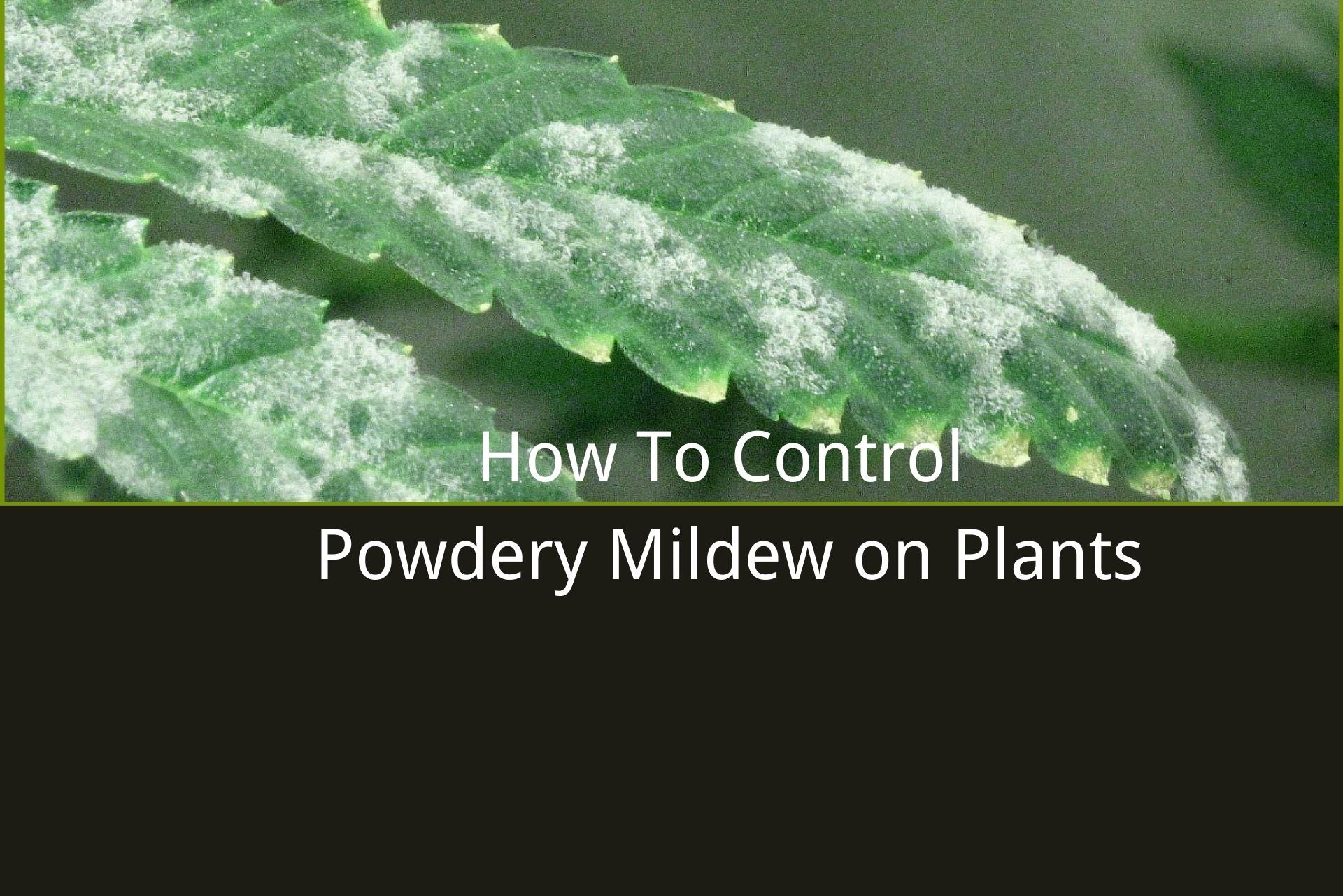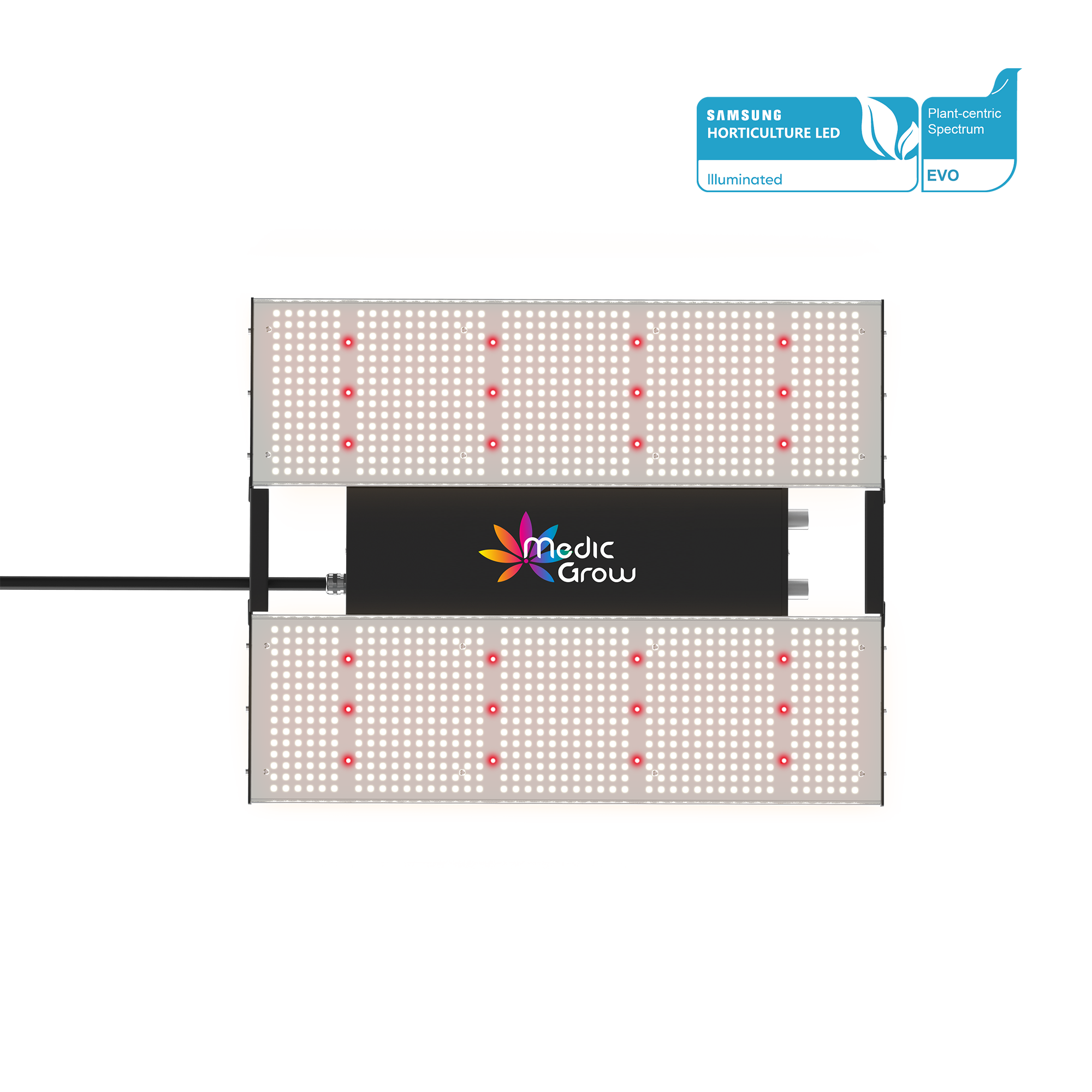
How To Control Powdery Mildew on Plants
Powdery Mildew on plants can affect the appearance of your plants and the quality of the yield.
Detection and identification of such diseases are essential for minimizing damage to your crops and encouraging proper growth in plants with full-spectrum grow lights.
In this article, we will be talking about one of the most common fungal diseases that affect plants: Powdery mildew.
It's imperative to know how to identify and treat powdery mildew on plants as growers can mistake it for dust buildup or leaf spot disease.
The topics that we'll cover in this article are:
- Part 1: What is powdery mildew?
- Part 2: Common symptoms of powdery mildew on plants
- Part 3: What Causes Powdery Mildew on Plants?
- Part 4: How Does Powdery Mildew Spread?
- Part 5: How to treat Powdery Mildew on plants
- Part 6: Tips for growers to prevent Powdery Mildew
What is Powdery mildew?
Powdery mildew is a fungal disease that affects a variety of plants such as cucumbers, tomatoes, honeysuckle, roses, melons, zucchini, pumpkins, peppers, etc. It is one of the types of fungus on plants that growers (including amateurs) can easily recognize.
The distinct appearance of white or grey patches of fungal growth on the plant surfaces is what makes it easy for growers to spot powdery mildew early on.
The white or light grey powdery physical appearance comes from the masses of spores that are present on the plant's surface.

Image Source: grangettos.com
Powdery mildew is common in an environment where the days are warm and the nights cool. Since it is contagious, it can spread across different parts of the plant.
When the moisture content in the soil is low while humidity levels are high at the plant surface, the conditions become favorable for powdery mildew. The fungal disease can be caused by various fungi species such as Erysiphe or Leveillula.
This fungal infection can also pose health risks for people with respiratory problems or allergies. Powdery mildew is typically host-specific—this means that the fungi that are affecting a certain plant variety (for instance, the cucurbit family) in the canopy is unlikely to spread to another.
In the next part, let's take a look at the commonly seen symptoms of powdery mildew on plants.
Common Symptoms Of Powdery Mildew
Powdery mildew can easily be mistaken for leaf spot disease or downy mildew. Keep an eye out for these common symptoms to keep your plants healthy, sturdy, and safe:
The first sign of upcoming powdery mildew on leaves is pale yellow spots on the leaf of the plant.
At first, the fungus may resemble dust or look like a powdery build-up on the leaves, stem, or fruits of the plant. It begins appearing as pale yellow spots which slowly cover the lower and upper side of the leaves and then become bigger patches that spread across different parts of the plant.
Powdery mildew causes the leaves, buds, and foliage to turn yellow, dried, disfigured, and curled. New growth, i.e young leaves, is the most prone to damage.

Image Source: goodfruit.com
Growers may notice mildew on fresh flower buds which may never bloom. The mildew may be white or light grey in the beginning and change its color to brown or grey later.
The fungus may also affect flowering or blooming and this can have an impact on the quality and quantity of the harvest. It can also lead to premature ripening or decreased yield from the infected areas of the plant.
Powdery Mildew Vs. Downy Mildew
It's important to know what powdery mildew on leaves looks like to ensure that growers don't get confused between powdery mildew and downy mildew.
The first and foremost difference between the two is their appearance: powdery mildew is a white or light grey powdery fungal growth on the upper side of the leaves. In some cases, it may cause yellow spots or grow on the undersides of the leaves as well.
On the other hand, in the case of downy mildew, the undersides of yellow spots are covered by a layer of fungus.

Image Source: wikipedia.org
While all fungal diseases can harm your plants significantly, downy mildew is slightly harder to manage and causes more harm to the plants than powdery mildew.
Wondering what causes powdery mildew on plants? Hmm.. Allow us to explain it in the next part.
What Causes Powdery Mildew on Plants?
Powdery mildew thrives in a surrounding with high relative humidity (more than 95%) and moderate temperatures (about 68° to 86°F)
Several growers choose to grow under artificial lighting systems such as LED grow lights. This allows them to grow any plant in an enclosed space wherever they want.
However, indoor gardening comes with its own set of problems. Having bad airflow inside the growing area encourages the growth of powdery mildew. This is why greenhouses without ventilation or air circulation offer the perfect breeding environment for spores.
Powdery mildew can be caused by a number of fungal species such as Erysiphe, Leveillula, Microsphaera, Oidium, Podosphaera, Sphaerotheca, Phyllactinia, etc.
Powdery mildew fungi are obligate parasites—which means that they take nutrients from the host plant to grow and reproduce. A majority of these fungi grow on the surface of the host plant.
Powdery mildew can be easily prevented and treated using chemical fungicides, biological fungicides, organic fungicides, home remedies, etc.
How Does Powdery Mildew Spread?
Powdery mildew has lightweight spores that can be easily carried away by the air currents from one plant to another.
They can also be transported through infected agents such as gloves, pruners, shears, and other gardening equipment.
Upon landing on the new host plant, the spores (conidia) start germinating, penetrating the plant tissue and infecting the plant. Since they are obligate parasites, they require healthy and lush green plants to take nutrients from.
Certain powdery mildew fungi require high humidity while others can thrive even in low humidity environments. It affects plants that fall in shaded areas particularly more than plants that are kept in sunny areas.
Powdery mildew favors warm and dry surroundings and doesn't spread quite as well when the weather is cold/rainy.
In the next part, let's learn how to treat Powdery mildew on plants.
How To Treat Powdery Mildew On Plants
There are numerous ways to treat powdery mildew on plants. Here are some of them:

Image Source: thespruce.com
Removing the infected parts of the plant:
If the mildew has only infected a small portion of the plant, you can snip off that part and carefully discard it. Make sure that you use clean pruners or shears and that you disinfect the equipment with alcohol wipes after use.
Keep an eye on the plant over the next few days/weeks to ensure that it doesn't reappear.
Of course, if the mildew has spread drastically and has infected several plants, growers can't remove or damage them. This is when the next few treatment methods will come in handy.
Use a fungicide:
There are many fungicides available in the market such as sulfur or copper-based fungicides, biological fungicides, chlorothalonil, organic fungicides, etc.
While using fungicides, make sure to follow the instructions written on the product's packaging and reapply every 7-14 days as required.
Milk Solution:
A milk solution is a simple, hassle-free, inexpensive, do-it-yourself method for powdery mildew treatment. Growers suggest making a solution of milk and water and spraying that on the plants. Use the ratio of one portion of milk to 2-3 portions of water.
Baking Soda Solution:
This is an effective and budget-friendly powdery mildew treatment method for dealing with powdery mildew on plants.
For this, you need to take a gallon of water and add to it a tablespoon of baking soda and half a teaspoon of liquid, non-detergent soap. After snipping off infected areas, spray this powdery mildew baking soda solution on all parts of the plant and on plants that are located in the surroundings.
Additionally, make sure to do a patch test on one leaf or one portion of the plant to see how it reacts to this solution.
One can also replace the powdery mildew baking soda with the same amount of potassium bicarbonate to treat any existing fungal infections.
Next up, we have a few tips for growers to prevent powdery mildew on plants.
Tips For Growers To Prevent Powdery Mildew
If you think your plants are prone to fungal diseases such as powdery mildew, it's important to take necessary action to prevent it from occurring or spreading to other plants.
Here are a few tips to prevent powdery mildew on plants:
- Neem oil can be used to prevent pests and fungal infections. It has antibacterial and antifungal properties which makes it effective against various kinds of bacteria and fungi.
- Allow plants to have adequate space between them. If required, you can prune or thin out plants to make space between them for air and light to pass. This helps curb the spread of mildew.
- Excessive fertilizing your plants during a powdery mildew infection is a bad idea as the new growth can be prone to powdery mildew development.
- To prevent the infection from spreading further, remove the infected foliage using shears or pruners and use gloves to pick up any infected leaves that have fallen below. Throw these diseased leaves in the garbage bin and do not add them to your compost pit.
- After thoroughly cleaning the soil and picking up any diseased leaves, spread 1-2 inch layers of compost on top of your soil to create an inhospitable environment for spores.
- Wash off the plants in the morning to get rid of any spores. Doing so at night or in the evenings would create a suitable environment for spores—something that we don't want. A lot of people recommend watering plants from the top to wash off any spores on the surface of leaves. Even though this can be helpful in some cases, it can make the environment wet and damp and suitable for other infections.
- When growing in a grow room or grow tent kit, it's crucial to get rid of excess moisture and set up an efficient air circulation system. This ensures that air moves around the area and there is no fungal growth.
- With advancements in technology, several mildew-resistant seed varieties have been introduced in the market. So, next time you visit your local nursery, make sure to ask if they have such seeds available.
In the next section, let's take a look at some frequently asked questions.
FAQs: Frequently Asked Questions
Is Powdery Mildew Dangerous?
Generally, powdery mildew is not harmful to healthy humans. But prolonged exposure to massive amounts of spores can affect certain individuals by making them allergic or intolerant.
Powdery mildew ruins the appearance of the plant and if it spreads further and infects the crops, it can affect the quality and overall taste of the fruit. But it's rarely fatal and can be controlled, treated, and prevented.
If the mildew is left untreated, it can take nutrients from the host plant, preventing its growth and making it weak. As a result, farmers don't get the high-quality produce that they're hoping to get. It can affect the profit they make from this yield.
This is why it is imperative to treat the plant as soon as possible.
Which Plants and Vegetables Are Most Susceptible?
Powdery mildew affects a variety of plants including
- Cereal grains such as wheat and barley.
- Legumes such as soybeans and peas.
- Fruits such as grapes, apples, pears, melons, watermelons, and strawberries.
- Vegetables such as gourds, zucchinis, carrots, radishes, and pumpkins.
- Flowering plants such as roses and lilacs.
- Herbs such as rosemary and thyme.
- Nuts such as cashews.
Typically, plants belonging to the cucurbit family, nightshade family, legumes, lilacs, and roses are the most prone to infection.
Can Powdery Mildew Spread To Other Plants?
Some kinds of powdery mildew fungi species are extremely host-specific and only affect a certain species of plants.
For instance, the powdery mildew that has infected your tomatoes might not infect other plants in the growing area.
On the other hand, other species of powdery mildew may affect multiple hosts or multiple species.
Final Thoughts:
Powdery mildew causes stress to the plants and leaches nutrients from it, making them vulnerable to infections and diseases. With these preventive measures and treatment methods, you can keep fungal diseases at bay.
Related Posts:
When Should You Replace Your Grow Light Bulbs?
Sealed Grow Room Basics: What Growers Should Know?
How To Maintain The Ideal Grow Room Temperature
Featured Products
Blog Posts
Contact Us with Any Idea!
- Choosing a selection results in a full page refresh.
!
































